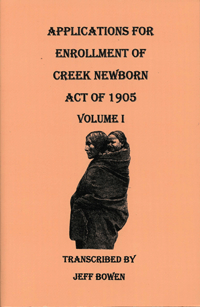 The Dawes Act of 1887 provided for the division of Indian lands to individual tribal members. This was an attempt to integrate the Indians into American society. The Five Civilized Tribes (Cherokee, Chickasaw, Choctaw, Creek, and Seminole) were excluded from the treaty. However, later efforts were made to garner their participation. The Curtis Act of 1898 required tribal population rolls, effectively a census, be compiled or recreated for each tribe. Tribal leadership resisted this effort until 1905. The Dawes Commission sent representatives to seven Creek Nation towns to collect names and affidavits for “newborns” making them citizens of the Creeks. Any children added to the rolls by May 2, 1905 would not be considered citizens of the Creek nation and thus eligible for a share of land. Applications for Enrollment of Creek Newborn Act of 1905 Volume I, by Jeff Bowen, contains transcriptions of these records.
The Dawes Act of 1887 provided for the division of Indian lands to individual tribal members. This was an attempt to integrate the Indians into American society. The Five Civilized Tribes (Cherokee, Chickasaw, Choctaw, Creek, and Seminole) were excluded from the treaty. However, later efforts were made to garner their participation. The Curtis Act of 1898 required tribal population rolls, effectively a census, be compiled or recreated for each tribe. Tribal leadership resisted this effort until 1905. The Dawes Commission sent representatives to seven Creek Nation towns to collect names and affidavits for “newborns” making them citizens of the Creeks. Any children added to the rolls by May 2, 1905 would not be considered citizens of the Creek nation and thus eligible for a share of land. Applications for Enrollment of Creek Newborn Act of 1905 Volume I, by Jeff Bowen, contains transcriptions of these records.
The results of the Dawes Commission was the eventual break up of the Five Civilized Tribes as social units. Parcels of land were distributed to individuals based on their level Indian blood, age, and family status. Children, “Newborns,” would receive 40 acres of tribal lands.
2,410 child applications were submitted by the deadline. Bowen’s transcriptions include all correspondence associated with the 1,171 successful Creek claimants. Each volume contains approximately 100 “newborns,” their parents, doctors, lawyers, midwives, and other Creek relatives. In all, about 2,000 Creek connections appear in this first volume.
“Newborn” were any Creek child age four or younger living within a qualified Creek (or other tribal) household, and was not an orphan.
Applications for Enrollment of Creek Newborn Act of 1905 Volume I is available from Family Roots Publishing; Item #: CF9805, Price: $35.28.